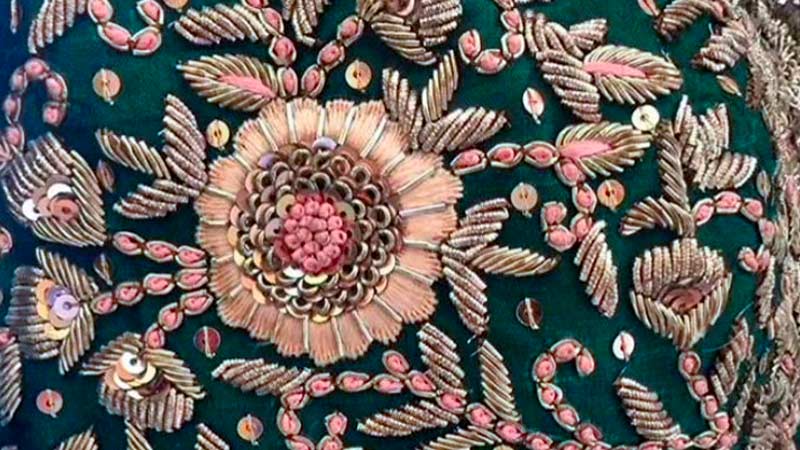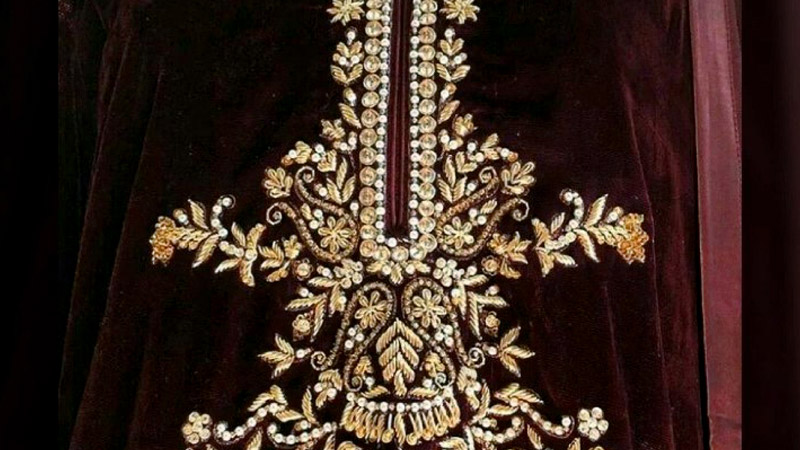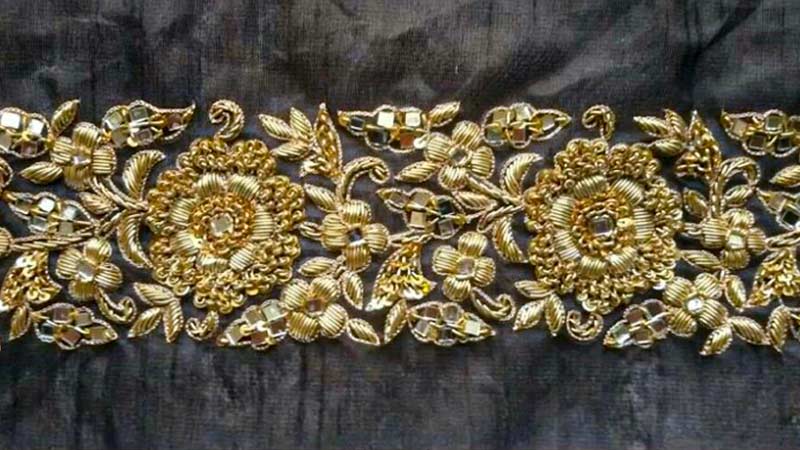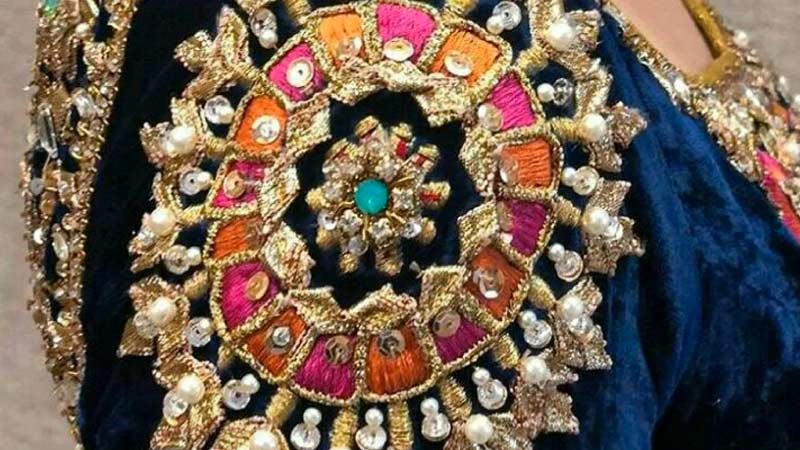In the ever-evolving realm of fashion, traditions often find innovative expressions, and one such time-honored artistry that continues to captivate the contemporary aesthetic is Zardozi’s work.
Originating in India, this intricate embroidery technique, characterized by metallic threads and embellishments, has adorned garments for centuries.
The question of whether Zardozi’s work is still in trend beckons exploration into its adaptability, its resonance with modern styles, and its persistent allure.
As fashion enthusiasts seek a harmonious blend of tradition and trendiness, delving into the current status of Zardozi in the fashion landscape unveils its enduring relevance and transformative journey in the dynamic world of style.

What Is Zardozi’s Work?
Zardozi’s work is a traditional Indian embroidery technique characterized by intricate patterns created with metallic threads, typically gold or silver, along with embellishments like beads and sequins.
The artistry involves meticulous hand stitching, producing opulent designs on various fabrics, including silk and velvet. Zardozi’s versatility spans traditional attire like sarees and sherwanis to modern fashion, accessories, and home decor.
Its enduring popularity is rooted in its timeless elegance, cultural significance, and the ability to blend traditional craftsmanship with contemporary styles, making each piece a unique and luxurious work of art.
Is Zardozi Work in Trend?

Yes, Zardozi’s work remains in trend, seamlessly blending tradition with modern fashion. This traditional Indian embroidery, characterized by intricate designs with metallic threads, continues to captivate fashion enthusiasts.
Designers creatively incorporate Zardozi into contemporary silhouettes, from clothing to accessories, showcasing its adaptability. The timeless allure of Zardozi’s opulent aesthetic, coupled with its cultural significance, keeps it relevant for diverse occasions.
Social media influencers and celebrities further contribute to its ongoing popularity, celebrating the artistry of skilled Zardozi craftsmen. The fusion of heritage and innovation ensures that Zardozi’s work maintains its prominence in the ever-evolving landscape of fashion.
Why Is Zardozi Work Popular in the Fashion Industry?

Zardozi’s work holds popularity in the fashion industry for several compelling reasons, making it a revered and sought-after embroidery technique:
Timeless Elegance
Zardozi’s work exudes a timeless elegance that transcends fashion trends. The intricate craftsmanship and opulent designs contribute to its enduring appeal, making it a classic choice for various occasions.
Luxurious Aesthetic
The use of gold and silver metallic threads, along with embellishments like beads and sequins, imparts a luxurious and regal aesthetic to Zardozi’s work. This opulence aligns well with high-end fashion and special occasions.
Cultural Significance
Zardozi often features traditional motifs and designs that carry cultural and symbolic meanings. Its connection to cultural heritage adds depth and authenticity, making it a choice that goes beyond mere fashion, appealing to those who appreciate the art’s history.
Versatility
Zardozi is highly versatile and can be adapted to various styles and fabrics. Its ability to seamlessly blend with both traditional and contemporary fashion makes it a favorite among designers looking for diversity in their collections.
Artisanal Craftsmanship
Skilled artisans primarily handcraft Zardozi’s work. The intricate detailing and precision involved in the embroidery showcase the artistry of these craftsmen, adding a personal touch and uniqueness to each piece.
Global Recognition

Zardozi has gained international acclaim, with designers worldwide incorporating it into their collections. Its presence on the global fashion stage has further solidified its popularity and influence.
Adaptability to Different Garments and Accessories
Zardozi’s work is not limited to specific types of clothing; it can be applied to a variety of garments, such as sarees, lehengas, and sherwanis, as well as accessories like bags and shoes. This versatility expands its reach in the fashion industry.
Celebrity Endorsements
Many celebrities and influencers showcase Zardozi’s work in their fashion choices, contributing to its visibility and endorsement in the industry. The association with well-known figures adds to its allure.
Heritage Preservation
Zardozi’s work plays a role in preserving traditional craftsmanship and heritage. Its continued use in contemporary fashion ensures that this age-old art form remains relevant and appreciated.
Attention to Detail
The meticulous attention to detail in Zardozi’s work sets it apart. The intricate patterns, precise stitches, and careful placement of embellishments reflect a commitment to quality and excellence.
How Has Zardozi Evolved in Modern Fashion Trends?

Zardozi, a traditional embroidery technique with roots in India, has undergone an evolution to adapt to modern fashion trends.
Here are several ways in which Zardozi has evolved in contemporary fashion:
Fusion with Western Wear
Designers have seamlessly integrated Zardozi into Western-style clothing, such as blouses, jackets, and dresses. This fusion brings a touch of traditional elegance to modern silhouettes.
Innovative Design Approaches
Contemporary designers experiment with innovative design approaches, incorporating Zardozi in unconventional ways. This might include asymmetrical patterns, abstract designs, or unexpected placements to create a modern aesthetic.
Casual and Everyday Wear
Zardozi, traditionally associated with festive and formal occasions, has found its way into casual and everyday wear. T-shirts, denim jackets, and even sneakers are now adorned with Zardozi work, making it more accessible for daily use.
Mixing with Other Embroidery Techniques
Designers often blend Zardozi with other embroidery techniques like threadwork, sequins, or beadwork. This mix creates unique and intricate textures, making the garment or accessory stand out.
Use in Accessories
Zardozi has extended beyond clothing to accessories like handbags, footwear, and even headgear. This allows individuals to incorporate the elegance of Zardozi into their style without necessarily wearing traditional garments.
Adaptation to Sustainable Fashion
With the growing focus on sustainability, Zardozi has found a place in the sustainable fashion movement. Artisans and designers may use eco-friendly materials and promote ethical practices while still preserving Zardozi’s artistry.
Global Influence and Acceptance
Zardozi has gained recognition on the global stage, with international designers incorporating it into their collections. This global acceptance has given Zardozi a broader audience and diversified its applications.
Inclusion in Bridal and Couture Collections
Zardozi continues to be a popular choice in bridal and couture collections. However, modern brides often seek contemporary designs, and designers have responded by infusing Zardozi into unconventional bridal wear.
Collaborations with High Fashion Brands
Collaborations between traditional Zardozi artisans and high fashion brands have brought this craft to the forefront. These collaborations often result in limited-edition pieces that merge traditional techniques with contemporary design sensibilities.
Social Media Influence
Social media platforms showcase how individuals incorporate Zardozi into their style. This has created a virtual space for fashion enthusiasts to share and celebrate the modern adaptations of Zardozi.
How Long Does It Take To Complete Zardozi Work?
The time required to complete Zardozi’s work varies based on factors like design complexity, artisan skill, and project size. Typically, Zardozi, a meticulous handcrafted embroidery, takes several days to weeks.
Elaborate designs or larger pieces may necessitate more time. The dedication of skilled artisans is evident in the detailed craftsmanship, contributing to Zardozi’s timeless appeal.
This intricate embroidery demands patience and precision, with completion times ranging from a minimum of a few days to several weeks, ensuring each piece is a labor of artistry and commitment to preserving this traditional craft.
FAQs
Is Zardozi’s work still in trend in contemporary fashion?
Yes, Zardozi’s work remains in trend, seamlessly blending tradition with modern styles. Designers and fashion enthusiasts continue to appreciate its timeless elegance.
Can Zardozi’s work be done on fabrics other than traditional ones?
Yes, Zardozi’s work is adaptable and can be done on various fabrics, including silk, velvet, cotton, and contemporary materials, allowing for diverse applications in modern fashion.
How has technology influenced Zardozi’s work in modern times?
While traditional handcrafted Zardozi remains prevalent, technology has facilitated machine-assisted processes for quicker production. However, handmade Zardozi retains its unique charm and authenticity.
Is Zardozi’s work only limited to garments, or can it be used for home decor?
Zardozi’s work extends beyond garments and is often used to embellish home decor items such as cushions, wall hangings, and table runners, adding a touch of luxury to living spaces.
Can I learn about Zardozi’s work as a hobby or as a personal project?
Yes, Zardozi work classes and tutorials are available for enthusiasts interested in learning the craft as a hobby or for personal projects. It’s a rewarding skill that can be acquired with practice.
To Recap
The exploration into the trendiness of Zardozi’s work reveals not only its steadfast presence but also its dynamic evolution in the contemporary fashion panorama.
From its rich cultural roots to its seamless integration with modern styles, Zardozi stands as a testament to the enduring appeal of traditional craftsmanship.
The fusion of luxury, versatility, and a timeless aesthetic ensures that Zardozi remains not just a trend but a captivating choice for those who appreciate the intersection of heritage and style.
As the fashion world continues to embrace diversity, Zardozi’s work prevails as a cherished art form, weaving a narrative of tradition that resonates with the ever-changing tapestry of fashion.
Leave a Reply